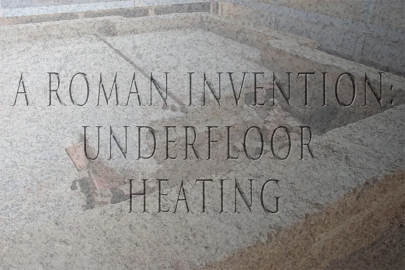A Roman Invention - Underfloor Heating

A Roman invention - Underfloor heating
Most people don't realise that underfloor heating is as old as it really is; it actually dates back to Roman times.
The Romans created a type of under floor heating that they called Hypocaust, it was by no means as sophisticated as the current under floor heating systems but it was very advanced in the Roman times.
How did the first underfloor heating system work?
The Roman underfloor heating system relied on the hot air that was generated by burning fires. Whilst homes or palaces were under construction, rooms would begin with floors on a foundation level. Across this level, a system of chambers would be built, so that there was an area between the floor of the room and the foundations for the hot air to flow. A furnace would be built under one corner of the room and stoking that furnace would produce the hot air needed to heat the room. The air would flow between the gaps in the floor and the room would warm up. Hypocausts were also used in wall construction so that heat came from the walls of the building as well as the floor. This type of heating was a sign of wealth, as servants would be needed to continually keep the fires going, and putting the under floor heating system in could increase the overall value of the building.
What's amazing is that once the Roman civilisation died out in Britain, many of their technologies, including underfloor heating, were simply abandoned, and its taken many hundreds of years before homeowners can once again benefit from this type of heating system.
The modern hypocaust system
Now underfloor heating works by either electric or a boiler. Underfloor heating uses a very similar theory to the hypocaust; the boiler heats the water which fills the pipes under the floor. The pipes are laid in a specific pattern to ensure that the heat is evenly distributed across the room, and the heat is controllable.
The growing demand for underfloor heating systems
People generally forget that the practice of under floor heating has been in use since the Roman period when they perfected the process. Under floor heating is environmentally beneficial and has fairly low running costs as it radiates heat from the floor upwards. The demand in the UK for under floor heating is growing at a rate of 90% a year.
The radiant energy that is being exhumed from the floor is absorbed by other surfaces in the room, which then become secondary radiant emitters. Underfloor heating ensures that there are no floor draughts and the temperature is even throughout the room. Alternative forms of heating such as radiators have the problem that they must be very hot before they can increase the room air temperature by any great amount. Another problem with radiators is that the hottest air rises to the ceiling and the coldest part of the room is at floor level.
Image used in featured image: By Valdavia - Own work, CC BY-SA 3.0
Related Posts
Sometimes the inventions which have had most impact on our everyday lives are the ones which we take the most for granted. Where would we be without the wheel, writing or even the internet? Another invention which we take for granted is the access to toilets and sewerage system, and it's not until you visit other countries which don't come up to Western European standards that you realise just how fortunate we are.
Don't want to have to pay for bath bombs? Here is how you can try and make your own bath bombs to add to your bath.
We are very lucky in the country to have clean running water to enable us to keep clean but what would happen if you didn't or couldn't wash for an extended period of time? We take a look.




